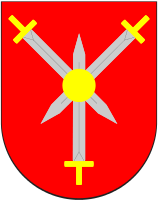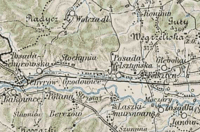Skelivka
Skelivka (Ukrainian: Скелівка; Polish: Felsztyn; German: Fullenstein) is a village in Lviv Oblast, Staryi Sambir Raion, Ukraine on the Strwiąż River. Felsztyn, as the settlement is called in Polish, was founded in 1374 by King Ludwik Węgierski. In 1488, Kazimierz Jagiellończyk brought in German burghers (the Herburt pl:Herburtowie family from Silesia and Moravia) and granted the Magdeburg rights. Skelivka was in previous times variously known as Fulsztyn, Folsteyn, Felstin, Fullensteyn, Fulsthine and Fulstin (1593). It is located a few kilometres from the border with Poland, in the eastern part of Bieszczady. During 966 - 1018, 1340 - 1772 (Ruthenian Voivodeship, Przemysl County) and during 1918 - 1939 Felsztyn was part of Poland (Województwo lwowskie). From 1772 to 1918 it belonged to the Austrian Empire (later the Austro-Hungarian Empire when the double monarchy was introduced in Austria).
Skelivka Skelivka | |
|---|---|
Village | |
 Flag  Seal | |
| Country | Ukraine |
| Oblast | Lviv Oblast |
| Founded | 1374 |
| Area | |
| • Total | 3.5 km2 (1.4 sq mi) |
| Elevation | 250 m (820 ft) |
| Population | |
| • Total | 1,062 |

On September 17, 1939, Felsztyn was incorporated into the Soviet Union, and since the collapse of the Soviet Union in 1991, is part of independent Ukraine. Skelivka is located near the towns of Przemyśl (in southeastern Poland) and Dobromil and Stryj (in western Ukraine). It is situated below the main watershed at the foot of the Carpathian Mountains, and has an elevation of 250 metres.
In the interwar years, Felsztyn had a mixed population of Poles, Ukrainians and Jews. The Jews were killed in World War II, while the area's Poles were deported to Siberia in cattle trucks after the Soviet invasion. Many of these Poles died in Siberia, some were able to leave Siberia with General Anders Army, while others eventually returned to Felsztyn in 1956 only to find their homes occupied by strangers or demolished. Most surviving Poles were moved to western Poland (mainly Lower Silesia) in the late 1940s and 1950s. After World War II, some Lemkos from Poland were moved to the renamed Skelivka. Today Skelivka is inhabited by Ukrainians and Lemkos. Until World War II, the town had a Roman Catholic church (and adjacent cemetery) which catered to the Polish population. During Soviet times the church was used as a barn and shed. It is now being restored as a Greek Catholic church.
A railway station of the Zagórz-Khyriv-Dobromyl railroad is located in Skelivka.
Population
- 1880 - 920
- 1936 - 1140
- 2001 - 1062
Notable people
- Dovid Shlomo Novoseller (1877-1966), rabbi and philanthropist
